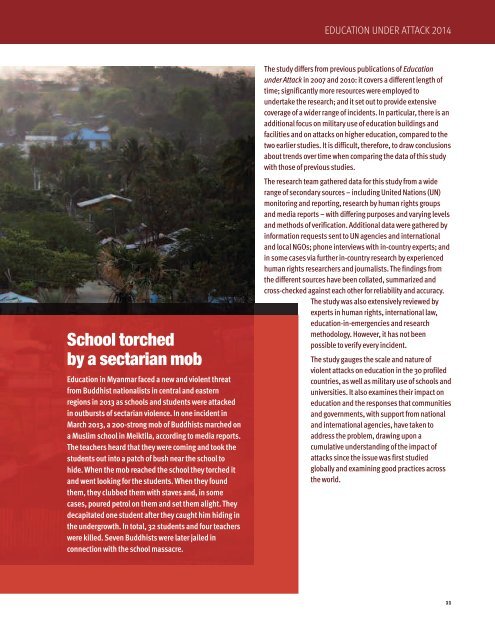You also want an ePaper? Increase the reach of your titles
YUMPU automatically turns print PDFs into web optimized ePapers that Google loves.
EDUCATION UNDER ATTACK 2014<br />
School torched<br />
by a sectarian mob<br />
education in Myanmar faced a new and violent threat<br />
from Buddhist nationalists in central and eastern<br />
regions in 2013 as schools and students were attacked<br />
in outbursts of sectarian violence. In one incident in<br />
March 2013, a 200-strong mob of Buddhists marched on<br />
a Muslim school in Meiktila, according to media reports.<br />
The teachers heard that they were coming and took the<br />
students out into a patch of bush near the school to<br />
hide. When the mob reached the school they torched it<br />
and went looking for the students. When they found<br />
them, they clubbed them with staves and, in some<br />
cases, poured petrol on them and set them alight. They<br />
decapitated one student after they caught him hiding in<br />
the undergrowth. In total, 32 students and four teachers<br />
were killed. Seven Buddhists were later jailed in<br />
connection with the school massacre.<br />
The study differs from previous publications of Education<br />
under Attack in 2007 and 2010: it covers a different length of<br />
time; significantly more resources were employed to<br />
undertake the research; and it set out to provide extensive<br />
coverage of a wider range of incidents. In particular, there is an<br />
additional focus on military use of education buildings and<br />
facilities and on attacks on higher education, compared to the<br />
two earlier studies. It is difficult, therefore, to draw conclusions<br />
about trends over time when comparing the data of this study<br />
with those of previous studies.<br />
The research team gathered data for this study from a wide<br />
range of secondary sources – including United Nations (UN)<br />
monitoring and reporting, research by human rights groups<br />
and media reports – with differing purposes and varying levels<br />
and methods of verification. Additional data were gathered by<br />
information requests sent to UN agencies and international<br />
and local NGOs; phone interviews with in-country experts; and<br />
in some cases via further in-country research by experienced<br />
human rights researchers and journalists. The findings from<br />
the different sources have been collated, summarized and<br />
cross-checked against each other for reliability and accuracy.<br />
The study was also extensively reviewed by<br />
experts in human rights, international law,<br />
education-in-emergencies and research<br />
methodology. However, it has not been<br />
possible to verify every incident.<br />
The study gauges the scale and nature of<br />
violent attacks on education in the 30 profiled<br />
countries, as well as military use of schools and<br />
universities. It also examines their impact on<br />
education and the responses that communities<br />
and governments, with support from national<br />
and international agencies, have taken to<br />
address the problem, drawing upon a<br />
cumulative understanding of the impact of<br />
attacks since the issue was first studied<br />
globally and examining good practices across<br />
the world.<br />
11


